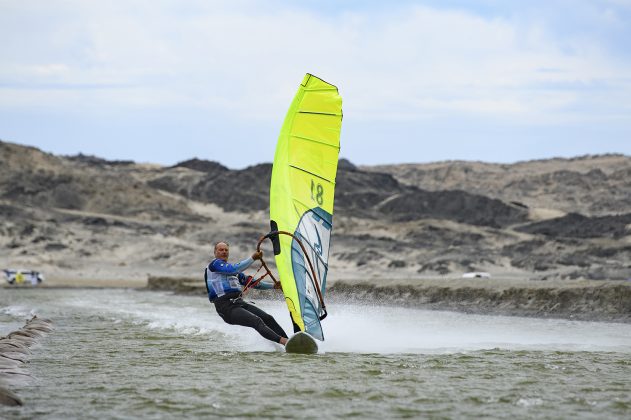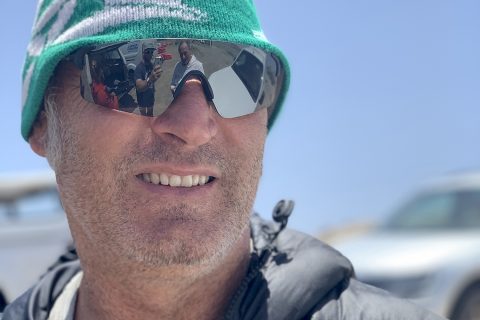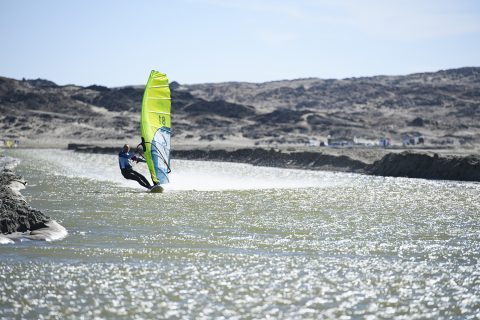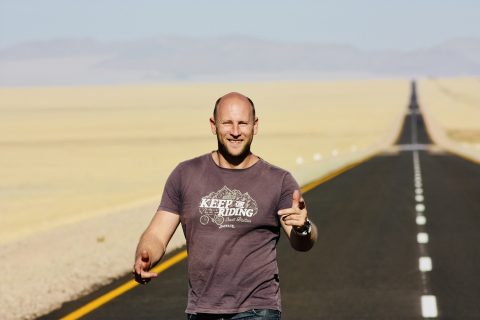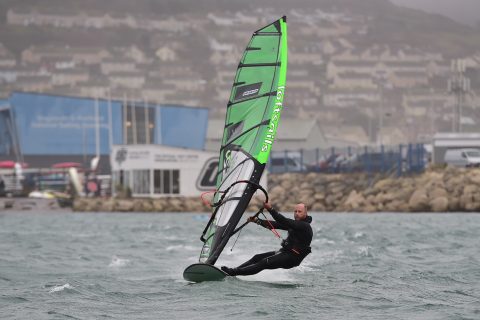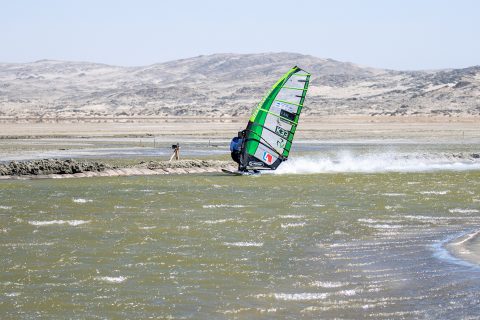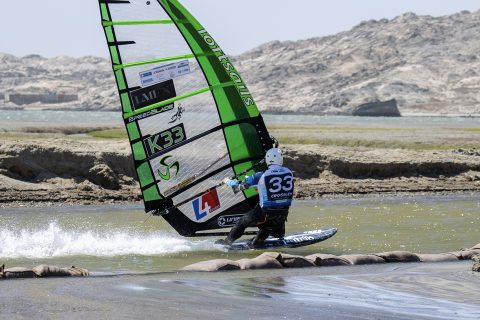SPEED SAILING: FASTER FASTER FASTER
If you want to go faster (who doesn’t?), then dive into these tips from two of the UK’s best speed sailors, Farrel O’Shea and Jim Crossley.
WORDS – Farrel O’Shea, Jim Crossley // PHOTOS – Jaco Wolmarans, Andrew Stallman, Jim Crossley.
Farrel O’Shea
Sheet In
- Farrel O’Shea
I can’t understate what appears to be both obvious and a given. Assuming you have reasonable wind for your sail size, sheet that back hand in hard! As hard as you can physically pull. This will close the magical slot between the foot of the sail and the deck of the board, minimising the vortex created by the high-pressure windward side of the sail trying to equalize under the foot to the low-pressure leeward side. Simultaneously the sheeting will transfer to lift on the foll of the fin and really drive the board forward.
Wind Angle
Sail as broad an angle as possible relative to the wind. There is no substitute for a good wind angle. Most of the time we are sailing a close reach across the wind. These tighter angles bring the apparent wind more to the front and give a comfy feeling of constant power and drive. Although it’s efficient in lighter winds, fast it’s not. Try to sail a broader reach, it’s a faster point of sailing full stop.
Of course, in most places the broader you go, the choppier it gets, but there’s always a workable line in between. The fastest windsurf spots on earth are not just windy, but broad angles too. The Lüderitz speed channel is 130-145 degrees, assisted here by very flat water, those extremely deep angles would be almost ‘un-sailable’ anywhere else.
- Farrel full speed
Equipment
Personally, I like to have a constant familiar feeling when I go sailing. That doesn’t matter if I’m going out for a blast across the bay, or down the speed course flat chat. To me the kit has to feel like a home from home. Free sailing my go-to kit is around a 100-litre slalom board, yet my specialist speed board is only 45 litres.
Crucially I set them up almost the same, stance width the same, mast foot position the same, boom height the same and harness line length the same. This red line common thread makes it second nature to jump from one to another and back again seamlessly.
To pin the tail on the donkey, my benchmarks are roughly 42 cm stance width, 130 cm mast foot to tail, 147 cm boom height (from deck) and 32 inch harness lines. Find out what works for you and make a note of it, and then you always have a reference point to fall back on.
Most of today’s equipment is fast, even freeride boards and sails. In this era you can also buy tried and tested “formula 1” kit off the shelf. That said speed and sailing fast is more a spirit, don’t feel that you have to have the latest and greatest to be in the game at any level. Remember we’re supposed to be having fun at this point – right?!
Tuning
If you want to go up a gear speed wise, it’s important to pay a bit of attention to tuning your stuff. You won’t go fast with a poorly prepared Ferrari, yet you could still get a tune out of an old Ford Escort. Sailing fast is a combination of power and control. To get more power, you simply need more sail. You have to sail at the edge of the envelope, think fully powered in the lulls and almost overpowered in the gusts. To keep things stable, downhaul is your friend. Simply put, more wind = more downhaul. All the clichés are relevant here, “more downhaul – less outhaul”. Don’t use more outhaul to compensate for more wind, you will just ‘over-flatten’ the sail profile, resulting in adverse handling.
For additional stability, maintain high batten tension, particularly in the long batten that crosses under the boom. The top batten at the head, as a rule, has no tension at all!
Stance
Stance is a really emotive subject in all aspects of windsurfing and speed is no exception. I don’t get too hung up on it and prefer to concentrate on being natural on the board rather than forcing myself into a stance that just don’t feel right. The masters of going quick just sail how they sail, but many folks get the magnifying glass out and ‘over study’ to try to replicate their heroes.
The critical point is to keep the rig upright, not raking it to windward, where upon the benefit of the gust acceleration and indeed control can be compromised. Right now there has never been a point where so many stances and styles have been acceptable – all of them going quick! There’s the low boomers at one end of the spectrum, used to great effect by the likes of Hans Kreisel and Vincent Valkenaers, and then there’s the classic style, represented by Antoine Albeau, Twan Verseput, and one of my favourite stances, Andy Laufer’s. Then there’s the raw power sailors, back in the day it was Thierry Bielak and currently it’s Gunner Asmussen. And there’s also the smooth gliders like Erik Beale and Oisín van Gelderen. In a nutshell there’s many ways to cook the egg here, much depending on your taste.
Tech
Very rarely few of us are going as quick as we think we are. Enter the GPS device, a fantastic tool for reference whether you’re blasting on the local pond or full throttle on a speed course. The GPS devices are pretty accurate and convenient, and there’s a readily available choice of waterproof wristwatch style GPS devices. They are super intuitive to use and easy to post your results, if that’s your bag, on the “Strava” of windsurfing – gps-speedsufing.com. The GPS speed community is really strong and in good hands here!
Finally make sure your kit is brightly coloured and co-ordinated; to quote Anders Bringdal – “if you can’t be fast, you better look good going slow!” Hook in and hang on …Farrel.
Jim Crossley
- Jim Crossley
Going through the gears
The feeling of going fast on a windsurfing board can only be beaten by one thing…going faster!
Over the years the bug of trying to go faster and faster on a windsurfing board has had a hold on me. It’s been a journey taking me through 30, 40 and then 50 knots, with max speed over 53 knots showing on my GPS. I’ve tested hundreds of boards, sails and fins on this journey and I’d like to share some of the most important lessons and tips I’ve picked up along the way.
Breaking 30 knots
Going 30 knots is a real challenge as it’s going to take more than just being able to blast up and down on your freeride kit to be able to achieve it. When choosing where to sail you are looking for somewhere with the least chop and the cleanest wind. It’s simply impossible to sail fast over medium sized chop so you need either flat water or more likely some clean rolling chop, where it’s possible to ride between the waves. It should be possible to hit 30 knots in any location with something like this.
- Jim Crossley sailing at Weymouth
The equipment
To go fast, probably the single most important thing is to be able to sail your board off the fin. By this I mean your back foot is pressuring the fin and the board is sailing off the tail. The board would ideally be a medium-sized slalom board, 105-125 litres with a flat rocker line from the front foot back to the tail. The fin would ideally be an upright design and not a raked fin. If the area under the front foot is spending most of the time in the water, the board isn’t flying. It’s really important to be able to find this balance point. Mast base position can be moved back step by step to also aid the board to fly. If the fin still isn’t producing enough lift, a lager fin size maybe necessary. It is not the case that a smaller fin will cause less drag and make you faster. Overall the lift from the fin reduces the wetted surface drag from the board significantly more than the drag from the fin itself. To be able to achieve this, it’s not necessary to have a cam sail, as modern rotational sails are perfectly capable of over 30 knots.
Tips to get you over the edge
So you’re happily reaching up and down your local spot at full power, it feels fast, your board is sailing off the fin and you check your GPS….26 knots. Yes this would be about right. So how do I break 30 knots! What you need to do is watch and feel the wind. To get this extra speed you need to watch for a gust as you feel the sail power up and engage the slingshot! By this I mean to bear away with the gust in a smooth curve. Too much too quickly and you will lose pressure on the fin, but if you get it right your board should be skipping happily across the water accelerating to full speed.
- Full power at Luderitz
Breaking 40 knots
Now we are getting into serious speed sailing territory. You will have already mastered the skills required for the 30 knot barrier and are looking to take things to the next level. Locations need to be chosen carefully; flat water with a maximum chop height of around 15 cm is ideal. You will be limited to sailing along some kind of wall or bank to shelter the water, but not the wind. The UK is blessed with a good number of really great spots suitable for going over 40 knots, including West Kirby, Southend and Kingsbridge, along with many harbour locations, where it is slightly more tricky, including Portland, Langstone and maybe Poole.
Simply by the nature of what we are trying to achieve here, the wind strength is going to be in the range of 35-45 knots. The equipment required is ideally a small slalom board or speed board. Ideal board widths for this target speed range from 44-63 cm. The slalom board option is best in the harbour type conditions, as a smaller board will not necessarily make you faster. Only with really flat water and stable wind will a speed board be preferable. It’s going to be a real benefit now to be on cammed sails between 5.0-6.3 to find the extra level of speed and control required.
40+ kit
It’s good to be on a quality carbon fin also for this. It would be preferable to use a quality slalom fin in a slalom board around 28-32 cm, but in a really flat water location where a speed board can be used it is better to use an asymmetric fin. This produces a lot more lift for its size, allowing you to use 1-2 cm smaller. As an example for a 45 cm speed board, a 21 cm asymmetric fin would be perfect. Note that they aren’t so good when you turn to the return tack and try to sail back upwind! Nearly all UK spots require starboard tack asymmetric fins.
There is quite a split between guys wearing waist harnesses and seat harness. At this level of windsurfing most people have developed their own preferences and styles, suffice to say there is more than one way to cook an egg.
- The need for speed!
Again to achieve this target speed you’re going to need to be quite brave with powering up the kit in a gust and bearing off the wind. It can really help to wear maybe 2-4 kg of weight in a weight jacket, especially if you are a light to medium build. It’s important that the weight is carried in a purpose made jacket that typically also acts as extra buoyancy and protects the body from wipeout impacts. A number of windsurf accessory companies produce the jackets, including Pro Limit and Liberty. The extra weight just helps stabilise the rider so as to not get lifted in the gusts and convert power into speed.
What it takes to break 50 knots
Again the UK has some of the best locations in the world with West Kirby, Southend and Kingsbridge all having speeds clocked over 50 knots. Other locations that clock these speeds regularly are the South of France and a good number of spots in the Netherlands. Namibia is of course at the centre of the plus 50 knot speed scene with the Lüderitz canal there being the fastest water in the world and nearby Diaz Point, the fastest open water in the world!
The equipment required is a speed board 40-45 cm wide with an asymmetric fin 19-21 cm and sail size 5.0-5.5. Now we are really pushing the limits of the same techniques used to break 30 and 40 knots and the limits of windsurfing overall. Winds gusting around 50 knots are ideal, so things can get risky and it is advisable to carry out a little risk assessment for yourself to check you have some kind of plan if things go wrong. Coming off your board at anything over 40 knots is quite an impact. One thing I have learned is to try and tuck in arms and legs like a bouncing bomb! Any limb that catches in the water while bouncing along can potentially cause injury to shoulders and knees for example.
Keeping track
There are lots of smart watches available now to keep track of how fast you go. One thing I really recommend is to upload your sessions to www.gps-speedsurfing.com. It’s really useful to keep a record of your session results to track progress. A list of verified devices for rankings on www.gps-speedsurfing.com includes: Coros Vertix & Coros Apex Pro; Motion GPS; Gyro1; GW-60, GT-31/BGT-31 and GX-52.
You can use non-verified devices for fun rankings, but your results won’t feature in record rankings. The website has lots of other useful information to help you get you started on tracking your speed journey, but ultimately, to go fast, what I have learned is you need to be in the right place at the right time, with the correct equipment ready to go!

